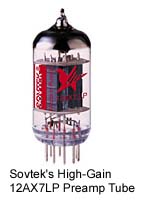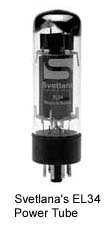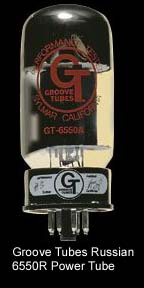While digital modeling has caught the attention of many players today, tubes and tube amps are far from dead. And even with the new digital modeling technology, which indeed is designed to try and emulate the sounds of world-famous tube amps from the past and present, there seems to be a resurgence in the number of tube amp options that are out there. One of the strengths of a good tube amp is its ability to respond to the dynamics of a guitar player’s picking attack when a tube is being overdriven. In addition, no solid-state or digitally modeled amplifier sounds as good as a tube amp when played over a loud band. In fact, it is at loud volumes where tube amps really come alive, while solid state and digitally modeled amps will often become thin and have harsher high-frequency emphasized tones.
Since tube amps and tubes themselves are certainly here to stay, I thought it would be appropriate to talk about vacuum tube basics. This article’s purpose is simple: to discuss what tubes do, describe the different tube types and how they each sound. Afterward, we’ll discuss briefly about what to look for when shopping for tubes and getting them installed.
All About Preamp Tubes
Preamp tubes are the group of smaller tubes found within an amplifier. In a typical Marshall head (pre-JCM 900), as well as many heads from most companies prior to their “high-gain” designs, the circuit would utilize an average of three tubes. Each tube has a slightly different role, but in the most simple terms, the job of the preamp tube stage is to take the signal from the guitar, shape the tone, and then amplify it enough to give it a good signal for the power amp. Preamp tubes can have different functions, such as being used as a driver for reverb circuits, but we’ll keep to the basics in this article.
The earliest amps from Fender and Marshall used one volume knob per channel on them only. As you turned up the volume control, the preamp and power amp sections would increase in level respectively together. This worked great, but you’d have to turn up the amp to a loud volume to get the best distortion. Later it was discovered that by limiting the output of the power amp stage, and including another volume control solely for the preamp stage, some pretty interesting distortion resulted because now the preamp tube could be easily overdriven at lower volumes. In fact many companies have made it their bread and butter to focus on the preamp stage, and some added additional tubes for even more preamp-tube gain, while continuing to carefully shape the tone of the preamp circuit. Mesa-Boogie was really the pioneer for high-gain preamp tube-oriented designs, and they based their original Mark I amplifiers on modifications that were done to the preamp stage of Fender Princetons.
 The most common preamp tube used in today’s amplifier circuits is called the 12AX7 (European equivalent is ECC83). The modern 12AX7 tube has the highest amount of gain available when compared to other common preamp tube types such as the 12AT7 or the 12AU7. Any of these tubes can be interchanged within an amplifier circuit and will not do any harm. A 12AT7 tube will have about 70% of the gain of a 12AX7 while a 12AU7 will have approximately half. High-gain is not always desirable by players since some will want a dynamically cleaner sound with more headroom and less compression.
The most common preamp tube used in today’s amplifier circuits is called the 12AX7 (European equivalent is ECC83). The modern 12AX7 tube has the highest amount of gain available when compared to other common preamp tube types such as the 12AT7 or the 12AU7. Any of these tubes can be interchanged within an amplifier circuit and will not do any harm. A 12AT7 tube will have about 70% of the gain of a 12AX7 while a 12AU7 will have approximately half. High-gain is not always desirable by players since some will want a dynamically cleaner sound with more headroom and less compression.
The job of the power amp stage in an amplifier is simple – take the preamp’s boosted signal and amplify it further to put enough power to drive a speaker or a group of speakers. The power tubes in an amplifier are the larger sets of tubes. Fifty-watt amplifiers typically use a pair of power tubes, while 100-watt designs will use two pairs.
There are many different types of power amp tubes used; the most common are the EL-34, 6L6, EL-84, and 6550. The EL-34 is the classic tube used in virtually every Marshall amp produced. It also has a younger sibling, the EL-84, that was used in some smaller Marshall combo designs as well as in Vox amplifiers (most famous was the Vox AC-30). The tone of an EL-34 is pure rock. Dynamic and full-toned at lower to mid volumes, while at higher volumes the EL-34 is easily overdriven and compresses to have a smooth distortion characteristic. EL-34’s and EL-84’s are both classic favorite tubes for both classic and modern guitar sounds.
The 6550 on the other hand, is quite different. Used in amplifiers that either required a great deal of power, or because there was a desire to have a longer lasting, more durable tube, the 6550 is difficult to distort (or rather we should say COMPRESS – more on this in a bit). It was used in classic amps such as Ampeg’s SVT line of bass amplifiers for a clean and tight punchy sound as well as in 70s’-era Marshalls. In the case of the Marshalls, Marshall’s U.S.A. distributor was looking for a more durable tube that wasn’t so fragile so it was decided to go with the 6550. The decision had nothing to do with the tone of the Marshall. In fact, when this occurred, complaints happened about how the newer Marshalls didn’t sound as good as the older ones. Fortunately, making the conversion from a 6550 to an EL-34 is a relatively uncomplicated process and only requires adjustment of the amp’s internal bias. Without going into too many details, the bias simply controls the amount of voltage going through the tubes. A 6550 requires more voltage than an EL-34 and therefore adjustments need to be made to compensate.
 When all is said and done with regards to the 6550, many people did and do in fact prefer the 6550’s tone. In a master volume style Marshall, when turning the preamp gain full up, and then adjusting the master volume to a suitable level, a 6550 equipped design will let the amp be played at a much higher level before any power tube compression will occur. This may not seem desirable, but the result was an emphasis in a the crunchy preamp distortion sound that many players like. To contrast – an EL-34 equipped master volume Marshall design with preamp gain set to full will often turn “mushy” when the master volume is turned up to encourage the power tubes to compress.
When all is said and done with regards to the 6550, many people did and do in fact prefer the 6550’s tone. In a master volume style Marshall, when turning the preamp gain full up, and then adjusting the master volume to a suitable level, a 6550 equipped design will let the amp be played at a much higher level before any power tube compression will occur. This may not seem desirable, but the result was an emphasis in a the crunchy preamp distortion sound that many players like. To contrast – an EL-34 equipped master volume Marshall design with preamp gain set to full will often turn “mushy” when the master volume is turned up to encourage the power tubes to compress.
This is one of the reasons why many players still prefer the sounds of the original Marshall Super Lead, with EL-34s, which LegendaryTones wrote about previously.
The last commonly used tube is the 6L6. This tube type is often found in Fender, Mesa-Boogie, Peavey, as well as numerous other amplifiers. It has strong popularity for two reasons. It is plentiful and therefore less expensive then the 6550 or the EL-34 as well as having a type of “best of both worlds” sound and design. More rugged than an EL-34, the 6L6’s tone could be thought of as a cross between the EL-34 and 6550 making a happy medium. Not as easy to compress as a common EL-34, but the 6L6 can provide its compression much sooner than a 6550.
Preamp vs. Power Tube Distortion – Let’s talk COMPRESSION
Preamp tubes that are distorted sound much different than power tubes. When a preamp tube is distorted, it creates a crunchy type of sound that is quite popular especially with today’s hard rock and metal crowd. Those that prefer a different type of tone may opt to either turn down the preamp volume control and/or use a less gain-heavy tube such as a 12AT7. Preamp tube distortion does not have as much of a dynamic character with regards to a player’s picking attack, but for full out distortion sounds, preamp tube distortion is quite popular and easy to accomplish. Especially when volume is a concern and things have to be kept down.
 Power tubes provide a much more dynamic feel and sound. When pushed to clip, power amp tubes become sensitive to the player’s touch and will, as a result, seem more organic and musical. It’s actually a type of compression really more than “distortion”. If you haven’t spent time playing a well-maintained and quality tube amplifier at a loud volume, it’s worth the experience. Of course, the problem with power tube overdrive is that volume is a requirement. In today’s club scene, etc., many guitarists just don’t have the opportunity to play at the necessary volumes to make these amps sound their best and therefore they’re probably a bit unpractical. Fortunately, there are things that can be done (see the tone tips and tricks article on the Marshall Super Lead here for ideas).
Power tubes provide a much more dynamic feel and sound. When pushed to clip, power amp tubes become sensitive to the player’s touch and will, as a result, seem more organic and musical. It’s actually a type of compression really more than “distortion”. If you haven’t spent time playing a well-maintained and quality tube amplifier at a loud volume, it’s worth the experience. Of course, the problem with power tube overdrive is that volume is a requirement. In today’s club scene, etc., many guitarists just don’t have the opportunity to play at the necessary volumes to make these amps sound their best and therefore they’re probably a bit unpractical. Fortunately, there are things that can be done (see the tone tips and tricks article on the Marshall Super Lead here for ideas).
A premium quality tube used to mean a tube that was produced in the United States, England, and Germany. However, none of those countries are producing tubes any longer and the world’s tube production has shifted to countries such as Russia, China, and Yugoslavia. It must be said though that especially now, tube quality has improved dramatically, compared to even ten years ago. As a result, getting a quality tube should not be a problem.
When going to the store, you may notice brands such as Groove Tubes, Mojo, Audio Glassic, etc. These companies in fact are not tube manufacturers (however this has changed regarding Groove Tubes. See addendum note below regarding Groove Tube’s recent announcement), but are companies that buy tubes from the different available sources, test them and sometimes rate them for performance characteristics, and then sell them under their name. For the person interested in assuring that they’ve received a quality tube and are not concerned that they’ll pay a premium, buying tubes from a company such as Groove Tubes is the way to go. Addendum note 4/30/02: Groove Tubes has recently announced that it has begun production of certain tubes in the U.S. within its own factory! This is excellent news and Groove Tube’s first offering is a 6L6 type designed and made using parts and tooling from General Electric and is essentially a reissue of the General Electric produced 6L6, long out of production. We look forward to Groove Tube’s other offerings in the future, especially an EL34/6CA7 tube.
Major tube manufacturers overseas (Sovtek, Svetlana, and JJ/Tesla factories also now sell their tubes direct through distribution channels under their own brands. In terms of general quality, the Svetlana and JJ/Tesla companies are thought of with the highest regard, with Sovtek and Ei following behind slightly. Chinese tubes are considered the poorest of quality – however they are also available at the lowest price and certainly some people may even prefer them. In terms of 12AX7 tubes, Chinese tubes have actually been popular lately for harder-rock/heavy metal players looking for extra gain.
A company such as Groove Tubes sells tubes from all of these sources and prices them accordingly with the Chinese tubes being less cost for less life. Groove tubes will also performance rate and “match” a set of tubes so that they respond and work equally within an amplifier’s circuit. Using the philosophy of the circuit only being as strong as its weakest link, Groove Tubes was the innovator of this idea of matching tubes for better tube sound.
Now, however, other manufacturers such as Svetlana and JJ also offer matched sets of tubes. Note that “matching” tubes refers to power tubes only. Preamp tubes all fall within the same basic tolerances and in fact are self-biasing to the circuit they are in.
A category of tubes that should be mentioned are NOS (New Old Stock) tubes. These are left-over stock from the earliest tube companies such as Mullard, Telefunken, and General Electric. Many tube purists won’t use anything but NOS tubes, but of course as supply dry up, prices also move upward accordingly. My personal thoughts on this topic are that NOS tubes, while undoubtedly good, are well overpriced for what may be a marginal –if any- improvement in tone. Also, with a NOS tube, you’ll never be quite certain if the tube is truly new, or if it has been used and then put back in its packaging. Sure you could use a tube tester to determine all of this for some added hassle. But certainly today’s companies that are manufacturing tubes are doing a good job and I’d recommend trying them first. If you still aren’t quite satisfied with your tone, perhaps then trying a NOS tube may be the right solution – or perhaps trying another amp.
After The Purchase: Getting Them Installed
Just a few words here: Installing tubes is easy, but what is important is to make sure your amp gets properly biased. If the current flowing through the power tubes is too high, you’ll burn through your set of tubes too quickly. If the current is too low, the amp won’t sound as good as it should. Having a tech install tubes and bias an amp is inexpensive and will range from about $25-$50 and is well worth doing.
If you are set on installing tubes and then biasing the amp yourself, Groove Tubes sells a bias tool kit that includes a comprehensive manual. Go to www.groovetubes.com for more information. Also it should be noted that the circuits within a tube amp use extremely high voltages, in the range of 300-400 volts and often more. These voltages can kill, so please don’t go playing with your amp if you don’t know what you’re doing. If you want to learn, there are books on the subject – otherwise leave it to the professionals.